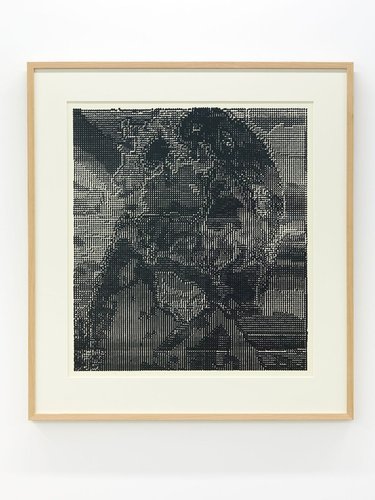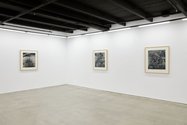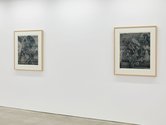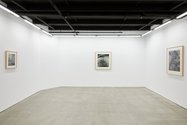John Hurrell – 8 October, 2019
In a manner that Ingram has never shown before, these works really jog the viewer's imagination, letting free association spin out of control—desirably so. They seem connected to Piranesi or Ernst, evoking different mental sensations upon each new visual examination and reflective rumination. Though revelling in a flat picture plane via the grid, they are also spatially ambiguous. Some have a lot of depth and are surprisingly visceral.
Five works by Simon Ingram, using his familiar method of a programmed painting robot, here utilize frameable sheets of paper under glass. For Ingram, this is unusual. We see a finer (more delicate) grid, with smaller dots and daubs, and far fewer strokes or linear wipes. Overall the final images are less abstract and denser, more compact.
The results are related to Chuck Close visually, but use two kinds of competing image constructing programmes where a more figurative image deviser is challenged by another more abstract system that attempts to second guess each section’s ‘intentions’. The resulting data from the clash is structured through twenty-two brushmark types so that wildly unexpected ‘deformities’ or ‘improvements’ occur. From a distance these intricate black-oil-paint-on-white-paper paintings—with their calculated ambiguities—could be prints that are oriented towards surrealism or sci-fi, in the manner (but less overtly ‘fanciful’) of, say, the English painter Glenn Brown and his ‘Auerbach’ heads.
In a manner that Ingram has never shown before, these dense and oddly graphic works really jog the viewer’s imagination, letting free association spin out of control—desirably so. They seem connected to Piranesi or Ernst, evoking different mental sensations upon each new visual examination and reflective rumination. Though revelling in a flat picture plane via the grid, they are also spatially ambiguous. Some have a lot of depth and are surprisingly visceral.
For me personally, Stonewall Alp Cliff shows a monstrous rearing head or shattered skull; Cloud Castle Specter a map of Europe mutating into a horse standing over the head of a giant fly; Mountain Glass House Cloud a view along the bow of a boat crashing through the sea, or a futuristic city (spouting flowers) in a storm; and Jellyfish Castle Thatch a foot standing on some unfortunate woman’s neck. Her breast is exposed. (The images merge objectivity with subjectivity, and so are like Rorschach tests—as is reviewing anyway. Perhaps I shouldn’t make them public.)
This is an exceptionally fulfilling exhibition where you need to experience the paintings directly yourself (not online) in the gallery—through your own body and your own mental/cultural matrix—to grasp what they offer. They are intimate in many senses of the word, being hard to walk past and not get imaginatively (and so, emotionally) involved. For Ingram, surely, a very exciting development.
John Hurrell








 Two Rooms presents a program of residencies and projects
Two Rooms presents a program of residencies and projects Advertising in this column
Advertising in this column



This Discussion has 0 comments.
Comment
Participate
Register to Participate.
Sign in
Sign in to an existing account.